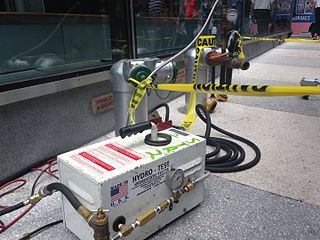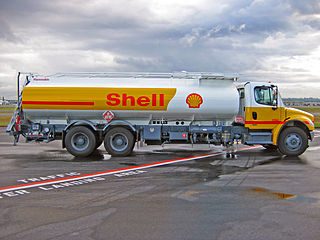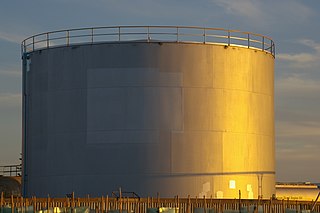


A fuel container is a container such as a steel can, bottle, drum, etc. for transporting, storing, and dispensing various fuels.



A fuel container is a container such as a steel can, bottle, drum, etc. for transporting, storing, and dispensing various fuels.
A wide variety of container types and constructions are used for fuels. Each has its own engineering challenges.
The jerrycan is a robust liquid container originally made from pressed steel. It was designed in Germany in the 1930s for military use to hold 20 litres (4.4 imp gal; 5.3 US gal) of fuel. Three handles allow for two people carrying a full can or one person handling an empty can. The basic design is still in use today although construction is often of high density polyethylene. [1]
Portable plastic gasoline containers are commercially available and are in common use. [2] These are usually blow molded polyethylene or other polymers compatible with the designated fuel. It has been found that the use of flame arresters reduces the chance of fire or explosion of gasoline. [3] [4] Child resistant caps or closures are required in some regions or jurisdictions. [5]
A drum (also called a barrel) is a cylindrical container used for shipping fuels. A typical drum has a nominal capacity of 200 litres (55 US or 44 imp gal). Drums are usually made of steel, but plastic drums are used for some liquids. Fuel drums need have the appropriate certification for shipment of dangerous goods: Flammable liquids, etc. Steel drums are suited for reconditioning for multiple uses.
Pouring of a flammable liquid has the potential of generating static electricity. Having the fuel container on the ground or having a grounding strap helps reduce the risk of sparks. In particular, loading a fuel container on a flatbed truck or vehicle can be dangerous because it is insulated. [6]
Shipments of flammable or explosive liquids are highly regulated. Based on the UN Recommendations on the Transport of Dangerous Goods model regulations, each country has coordinated design and performance requirements for shipment. For example, in the US, the Department of Transportation has jurisdiction and published requirements in Title 49 of the Code of Federal Regulations. [7]
The applicable regulation depends on the flash point of the fuel, quantity being shipped, mode of transit, etc.

Propane is a three-carbon alkane with the molecular formula C3H8. It is a gas at standard temperature and pressure, but compressible to a transportable liquid. A by-product of natural gas processing and petroleum refining, it is commonly used as a fuel in domestic and industrial applications and in low-emissions public transportation. Discovered in 1857 by the French chemist Marcellin Berthelot, it became commercially available in the US by 1911. Propane is one of a group of liquefied petroleum gases. The others include propylene, butane, butylene, butadiene, isobutylene, and mixtures thereof. Propane has lower volumetric energy density, but higher gravimetric energy density and burns more cleanly than gasoline and coal.

A portable stove is a cooking stove specially designed to be portable and lightweight, used in camping, picnicking, backpacking, or other use in remote locations where an easily transportable means of cooking or heating is needed. Portable stoves can be used in diverse situations, such as for outdoor food service and catering and in field hospitals.

The flash point of a material is the "lowest liquid temperature at which, under certain standardized conditions, a liquid gives off vapours in a quantity such as to be capable of forming an ignitable vapour/air mixture".

Liquefied petroleum gas is a fuel gas which contains a flammable mixture of hydrocarbon gases, specifically propane, propylene, butylene, isobutane, and n-butane.

A hydrostatic test is a way in which pressure vessels such as pipelines, plumbing, gas cylinders, boilers and fuel tanks can be tested for strength and leaks. The test involves filling the vessel or pipe system with a liquid, usually water, which may be dyed to aid in visual leak detection, and pressurization of the vessel to the specified test pressure. Pressure tightness can be tested by shutting off the supply valve and observing whether there is a pressure loss. The location of a leak can be visually identified more easily if the water contains a colorant. Strength is usually tested by measuring permanent deformation of the container.

A jerrycan or jerrican is a fuel container made from pressed steel. It was designed in Germany in the 1930s for military use to hold 20 litres of fuel, and saw widespread use by both Germany and the Allies during the Second World War.

A drum is a cylindrical shipping container used for shipping bulk cargo. Drums can be made of steel, dense paperboard, or plastic, and are generally used for the transportation and storage of liquids and powders. Drums are often stackable, and have dimensions designed for efficient warehouse and logistics use. This type of packaging is frequently certified for transporting dangerous goods. Proper shipment requires the drum to comply with all applicable regulations.

A gas cylinder is a pressure vessel for storage and containment of gases at above atmospheric pressure. High-pressure gas cylinders are also called bottles. Inside the cylinder the stored contents may be in a state of compressed gas, vapor over liquid, supercritical fluid, or dissolved in a substrate material, depending on the physical characteristics of the contents. A typical gas cylinder design is elongated, standing upright on a flattened bottom end, with the valve and fitting at the top for connecting to the receiving apparatus.

High-density polyethylene (HDPE) or polyethylene high-density (PEHD) is a thermoplastic polymer produced from the monomer ethylene. It is sometimes called "alkathene" or "polythene" when used for HDPE pipes. With a high strength-to-density ratio, HDPE is used in the production of plastic bottles, corrosion-resistant piping, geomembranes and plastic lumber. HDPE is commonly recycled, and has the number "2" as its resin identification code.

A tank truck, gas truck, fuel truck, or tanker truck or tanker is a motor vehicle designed to carry liquids or gases on roads. The largest such vehicles are similar to railroad tank cars, which are also designed to carry liquid loads. Many variants exist due to the wide variety of liquids that can be transported. Tank trucks tend to be large; they may be insulated or non-insulated; pressurized or non-pressurized; and designed for single or multiple loads. Some are semi-trailer trucks. They are difficult to drive and highly susceptible to rollover due to their high center of gravity, and potentially the free surface effect of liquids sloshing in a partially filled tank.

Intermediate bulk containers are industrial-grade containers engineered for the mass handling, transport, and storage of liquids, semi-solids, pastes, or solids. The two main categories of IBC tanks are flexible IBCs and rigid IBCs. Many IBCs are reused or repurposed.
A water tank is a container for storing water, for many applications, drinking water, irrigation, fire suppression, farming, both for plants and livestock, chemical manufacturing, food preparation as well as many other uses. Water tank parameters include the general design of the tank, and choice of construction materials, linings. Various materials are used for making a water tank: plastics, fiberglass, concrete, stone, steel. Earthen pots, such as matki used in South Asia, can also be used for water storage. Water tanks are an efficient way to help developing countries to store clean water.

Storage tanks are containers that hold liquids, compressed gases or mediums used for the short- or long-term storage of heat or cold. The term can be used for reservoirs, and for manufactured containers. The usage of the word tank for reservoirs is uncommon in American English but is moderately common in British English. In other countries, the term tends to refer only to artificial containers.

Oxy-fuel welding and oxy-fuel cutting are processes that use fuel gases and oxygen to weld or cut metals. French engineers Edmond Fouché and Charles Picard became the first to develop oxygen-acetylene welding in 1903. Pure oxygen, instead of air, is used to increase the flame temperature to allow localised melting of the workpiece material in a room environment. A common propane/air flame burns at about 2,250 K, a propane/oxygen flame burns at about 2,526 K, an oxyhydrogen flame burns at 3,073 K and an acetylene/oxygen flame burns at about 3,773 K.

A flame arrester, deflagration arrester, or flame trap is a device or form of construction that will allow free passage of a gas or gaseous mixture but will interrupt or prevent the passage of flame. It prevents the transmission of flame through a flammable gas/air mixture by quenching the flame on the high surface area provided by an array of small passages through which the flame must pass. The emerging gases are cooled enough to prevent ignition on the protected side.

A fire extinguisher is a handheld active fire protection device usually filled with a dry or wet chemical used to extinguish or control small fires, often in emergencies. It is not intended for use on an out-of-control fire, such as one which has reached the ceiling, endangers the user, or otherwise requires the equipment, personnel, resources or expertise of a fire brigade. Typically, a fire extinguisher consists of a hand-held cylindrical pressure vessel containing an agent that can be discharged to extinguish a fire. Fire extinguishers manufactured with non-cylindrical pressure vessels also exist but are less common.
A shipping container is a container with strength suitable to withstand shipment, storage, and handling. Shipping containers range from large reusable steel boxes used for intermodal shipments to the ubiquitous corrugated boxes. In the context of international shipping trade, "container" or "shipping container" is virtually synonymous with "intermodal freight container", a container designed to be moved from one mode of transport to another without unloading and reloading.

In technical usage in the shipping industry, a pail is a type of cylindrical shipping container with a capacity of about 3 to 50 litres. It can have straight or slanted sides and usually has a handle or bail.
Reusable packaging is manufactured of durable materials and is specifically designed for multiple trips and extended life. A reusable package or container is "designed for reuse without impairment of its protective function." The term returnable is sometimes used interchangeably but it can also include returning packages or components for other than reuse: recycling, disposal, incineration, etc. Typically, the materials used to make returnable packaging include steel, wood, polypropylene sheets or other plastic materials.

A water container, water canister or water can is a medium-sized portable container for transport, storage and use of water. Large plastic bottles are sometimes called "canisters". Water canisters can for example be used for drinking water, wastewater or showering. Water canisters are used for excursions, camping, boat trips, in cabins without tap water, or as a household drinking water reserve in case of emergency.
A flame arrester works by removing heat from a flame and keeping the temperature of the fuel on the other side of the arrester below its ignition point. The flame arrester mesh breaks the flame into many flamelets, and the heat of these flamelets is transferred to the walls of the mesh". (The link is to the abstract only: A free full-text link is on Google Scholar.)